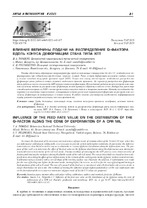| dc.contributor.author | Томило, В. А. | |
| dc.contributor.author | Пилипенко, С. В. | |
| dc.coverage.spatial | Минск | ru |
| dc.date.accessioned | 2024-01-19T10:47:21Z | |
| dc.date.available | 2024-01-19T10:47:21Z | |
| dc.date.issued | 2023 | |
| dc.identifier.citation | Томило, В. А. Влияние величины подачи на распределение Q-фактора вдоль конуса деформации стана типа ХПТ = Influence of the feed rate value on the distribution of the Q-factor along the cone of deformation of a CPR mil / В. А. Томило, С. В. Пилипенко // Литье и металлургия. – 2023. – № 4. – С. 81-87. | ru |
| dc.identifier.uri | https://rep.bntu.by/handle/data/139553 | |
| dc.description.abstract | Чтобы обеспечить образование микроструктуры труб из титановых сплавов типа Ti‑3Al‑2.5V, необходимо их деформировать при соблюдении определенных, строгих, условий. Такие условия деформации возможно создать только в станах холодной пильгерной прокатки труб (ХПТ). Только эти станы обеспечивают необходимое распределение Q-фактора вдоль рабочего конуса каждого отдельного прохода прокатки. На характер распределения Q-фактора вдоль рабочего конуса стана типа ХПТ влияет множество факторов. Целью данной работы является определение влияния величины подачи на распределение Q-фактора между прямым и обратным ходами клети. Выбирались различные способы ведения процесса ХПТ с точки зрения осуществления подачи и поворота заготовки. Методы исследования базируются на известных зависимостях, описывающих влияние различных параметров деформации на распределение величины Q-фактора по контрольным сечениям конуса. В работе также рассмотрены особенности деформирования трубы в такой зоне рабочего конуса, как зона предотделки. | ru |
| dc.language.iso | ru | ru |
| dc.publisher | БНТУ | ru |
| dc.title | Влияние величины подачи на распределение Q-фактора вдоль конуса деформации стана типа ХПТ | ru |
| dc.title.alternative | Influence of the feed rate value on the distribution of the Q-factor along the cone of deformation of a CPR mil | ru |
| dc.type | Article | ru |
| dc.identifier.doi | 10.21122/1683-6065-2023-4-81-87 | |
| local.description.annotation | To ensure the formation of the necessary microstructure of pipes made of titanium alloys of the Ti‑3Al‑2,5V type, when they are deformed at cold pilgrim rolling mills, it is necessary to provide certain deformation conditions. In particular, the deformation modes are distributed in such a way as to obtain the ne cessary Q-factor distribution along the deformation cone. The purpose of this work is to determine the effect of the feed value on the Q-factor distribution along the deformation zone during forward and reverse movements of the roll mill stand. 1Various methods of carrying out the CPT process were chosen in terms of feeding and rotating the workpiece during the double stroke of the roll mill stand. The research methods are based on known dependencies describing the effect of true deformations in the sections of the working cone on the Q-factor in these control sections. Calibration using a mandrel with a curved shape of the working surface was chosen for the analysis. 1 Calculations were made for the case of feeding rate before the forward stroke, turning before the reverse, as well as for the case of feeding and turning in both positions of the roll mill stand. The case of mismatch of the feed size is considered, when the feed before the reverse stroke is larger than before the direct one. The methods of leveling the influence of pipe deformation features in the wall calibration zone on the formation of the necessary microstructure of pipes made of Ti‑3Al‑2.5V alloys are proposed. | ru |

